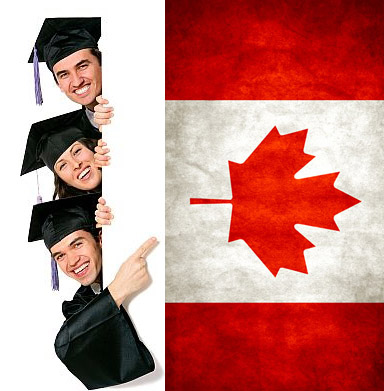


How Canada became an education superpower
When there are debates about the world's top performing education systems, the names that usually get mentioned are the Asian powerhouses such as Singapore and South Korea or the Nordic know-alls, such as Finland or Norway.
But with much less recognition, Canada has climbed into the top tier of international rankings.
In the most recent round of international Pisa tests, Canada was one of a handful of countries to appear in the top 10 for maths, science and reading. The tests, run by the Organisation for Economic Co-operation and Development (OECD), are a major study of educational performance and show Canada's teenagers as among the best educated in the world.
They are far ahead of geographical neighbours such as the US and European countries with strong cultural ties like the UK and France.
At university level, Canada has the world's highest proportion of working-age adults who have been through higher education - 55% compared with an average in OECD countries of 35%.
Canada's success in school tests is also very unusual compared with other international trends.
The top performers are often cohesive, compact societies and the current highest achiever, Singapore, has been seen as a model of systematic progress, with each part of the education system integrated into an overarching national strategy.
Canada does not even really have a national education system, it is based on autonomous provinces and it is hard to think of a bigger contrast between a city state such as Singapore and a sprawling land mass such as Canada.
The OECD, trying to understand Canada's success in education, described the role of the federal government as "limited and sometimes non-existent".

Also not widely recognised is that Canada has a high level of migrants in its school population.
More than a third of young adults in Canada are from families where both parents are from another country.
But the children of newly-arrived, migrant families seem to integrate rapidly enough to perform at the same high level as their classmates.
When the most recent Pisa rankings are looked at more closely, at regional rather than national level, the results for Canada are even more remarkable.
If Canadian provinces entered Pisa tests as separate countries, three of them, Alberta, British Columbia and Quebec, would be in the top five places for science in the world, alongside Singapore and Japan and above the likes of Finland and Hong Kong.
So how has Canada overtaken so many other countries in education?
Andreas Schleicher, the OECD's education director, says Canada's "big uniting theme is equity".
Despite the different policies in individual provinces, there is a common commitment to an equal chance in school.
He says there is a strong sense of fairness and equal access - and this is seen in the high academic performance of migrant children.
Within three years of arriving, the Pisa tests show the children of new migrants have scores as high as the rest of their schoolmates.
It makes Canada one of the few countries where migrant children achieve at a level similar to their non-migrant counterparts.
Another distinguishing feature is that Canada's teachers are well paid by international standards - and entry into teaching is highly selective.

Prof David Booth, from the Ontario Institute for Studies in Education at the University of Toronto, highlights Canada's "strong base in literacy".
There have been systematic efforts to improve literacy, with well-trained staff, resources such as school libraries and testing and assessment to identify schools or individuals who are struggling.
Prof John Jerrim, of the UCL Institute of Education in London, says that Canada's high league table ranking reflects the narrow socio-economic gap in school results.
Rather than a country of extremes, Canada's results show a very high average, with relatively little difference between advantaged and disadvantaged students.
In the most recent Pisa results for science, the variation in scores in Canada caused by socio-economic differences was 9%, compared with 20% in France and 17% in Singapore.
The equitable outcome goes a long way to explaining why Canada is doing so well in international tests. It does not have a tail of underachievement, often related to poverty.
It is a remarkably consistent system. As well as little variation between rich and poor students, there is very little variation in results between schools, compared with the average for developed countries.
Rather than high levels of immigration being seen as a potential drag on results, Prof Jerrim says in Canada's case, this is likely to be part of its success story.
Migrants coming to Canada, many from countries such as China, India and Pakistan, are often relatively well-educated and ambitious to see their children get into professional careers. Prof Jerrim says these families have an immigrant "hunger" to succeed, and their high expectations are likely to boost school results for their children.
Prof Booth from the University of Toronto also points to the high expectations of these migrant families.
"Many families new to Canada want their children to excel at school, and the students are motivated to learn," he said.
This has been a bumper year for education in Canada.
The universities are reaping the benefits of the Trump effect, with record levels of applications from overseas students seeing Canada as a North American alternative to the United States.
There has also been a Canadian winner of the Global Teacher Prize, with Maggie MacDonnell using the award to campaign for indigenous students. As Canada marks its 150th anniversary, it can claim the status of an education superpower.
Source: http://www.bbc.com/news/business-40708421